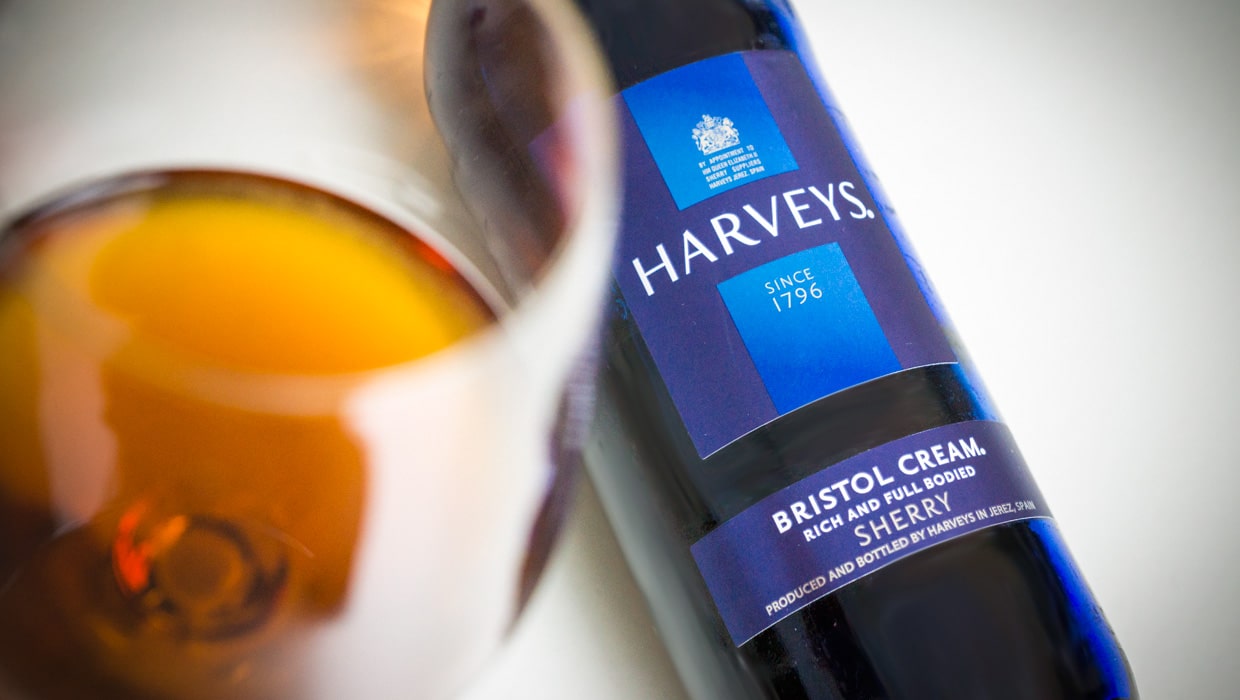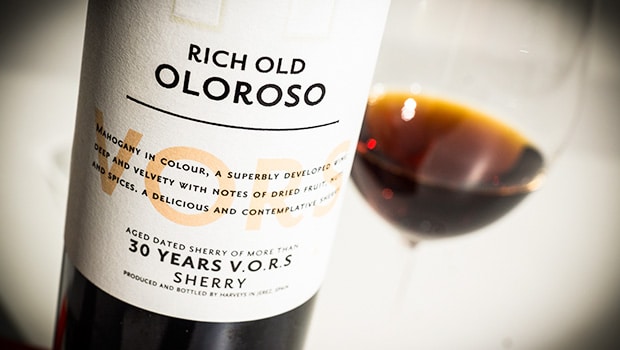
Medium / Cream
Cream sherry is the general name for different kinds of sweetened sherries. They are usually produced by blending a dry wine like Oloroso with naturally sweet Pedro Ximénez or Moscatel wines. Lesser quality Cream sherry will be sweetened (and coloured) by adding grape must and/or a vino de color, which contains Arrope, cooked down and caramelized grape must.
Medium sherry is half sweet. Often it will be based on a lighter style of sherry like Amontillado.
Sweet sherry used to be a hugely popular category, especially in certain export regions like the UK and Germany. However it is slowly losing ground in favour of the drier styles.
The Cream sherry category is named after a hugely popular product called Bristol Cream from Bodegas Harveys. Around 1860 they invented a kind of thick, sweet blend that originated in Bristol but conquered the world. Since the 1950’s this is the top selling sherry worldwide. Nowadays it’s still commonly found, but it is slowly becoming the symbol of an old generation of sherry drinkers that are not really looking for the dry, more authentic wines.
In Spanish this category of sherry wines is called Vinos Generosos de Licor or liqueur wines. They are separate from the naturally sweet wines or Vinos Dulces Naturales. Learn more about sherry categories on the website of the Consejo Regulador.
Cream sherry character
Don’t just ignore the category of sweetened sherries though. The best examples still rely on well-aged Oloroso or other dry types for most of their character. In this case Pedro Ximénez is only added as an enhancement (sometimes to balance out the rough edges of long ageing in wood).
The best examples of sweet sherry wines (e.g. Gonzalez Byass Matusalem or the Harveys Oloroso V.O.R.S.) are old, venerable wines. They are much more balanced than the cheap commercial types. The best sweet sherries are the ones that were sweetened long before bottling. That way, the sweeter wine will blend nicely with the dry one, creating a harmoniously end result. These wines are usually off-dry rather than thoroughly sweet.
Most of the blends are mixed right before bottling, but again the better examples return to a solera to mature further and integrate their flavours.

Oloroso Dulce from Bodegas Harveys
Types of sweet sherry
There are different labels for sweetened sherry, based on their sugar content and flavour:
- Pale Cream sherry contains between 45-115 grams of sugar per liter. It is composed around a biologically aged wine – Fino or Manzanilla – which explains the bright colour to which rectified grape must is added as a sweetener. A well-known example of this style is the Croft sherry.
- Medium sherry contains between 5 and 115 grams of sugar per liter. It is often composed around Amontillado, sometimes with a small amount of Oloroso added to it, as well as Moscatel and/or Pedro Ximénez.
- Cream sherry is between 115–140 grams. This sweet wine will generally be composed around Oloroso, usually blended with Pedro Ximénez.
- Dulce is the name for a naturally sweet sherry, produced like an Oloroso but as the fermentation is halted early. It is made from Palomino grapes and has some residual sugar in the final product (similar to a Port wine).
Another style worth mentioning is East India Solera, bottled by Lustau and named after the tradition of maturing wines in the holds of ships that sailed for the East Indies (this practice was not exclusive to sherry, also Madeira, whisky and other spirits were treated this way). The motion of the ship and the specific climatic conditions would create a softer, more gentle style of sherry. Today the style is recreated by blending some Pedro Ximénez with Oloroso and storing the resulting blend in the warmest parts of the bodega.
Appreciation
Because of its sweetness, it should be served chilled, between 10 and 12°C. It can be had in a wide variety of ways: with fruit salads, sweet apple pie or other kinds of pastry, after dinner on the side with a coffee, or with paté, foie gras and mature cheese. Some people tend to drink it as an aperitif, usually with ice, but this will not suit the purpose of an aperitif to start the appetite very well.
Medium / Cream sherry reviews
- ‘As You Like It’ Amontillado blend (Williams & Humbert)4
- 10RF Medium (Osborne)3
- A Winter’s Tale – Medium Sweet (Williams & Humbert)3
- Añada 1996 (Lustau 125 Aniversario)4.5
- Añada 1998 (Lustau)4
- Añada 2000 (Lustau)4.5
- Argüeso Cream3
- Bobadilla Black Label (1974 / 1975 / 1977)
- Canasta 20 Years VOS (Williams & Humbert)4
- Canasta Cream (Williams & Humbert)2.5
- Contrabandista (Valdespino)3.5
- Cream Leona (Viuda de Manjón)3.5
- Cream VOS (Bodegas Tradición)4.5
- Dry Sack Medium (Williams & Humbert)2.5
- East India Solera (Lustau)3.5
- Embassy Palo Cortado Medium (Barbadillo)3
- Eva Cream (Barbadillo)3.5
- Harvey’s Bristol Cream2
- Harveys Signature 12 Year Old Cream4
- Isabela Cream (Valdespino)3.5
- Medium Contubernio (Vinos Según Cede)4
- Mírame cuando te hablo (Romate)3.5
- Old Harvest Medium Dry 2014 (Ximénez-Spínola)4.5
- Poley Cream 10 Años (Toro Albalá)4
- Royal Cream (Marqués del Real Tesoro)1
- San Rafael Medium (Barbadillo)3.5
- Tres Cortados Medium Dry (Valdespino)3.5
- Vina Dulce Nombre 2|8 vs 1960 (González Byass)4.5
- ¿Fuego? No Thanks (Romate)2.5






